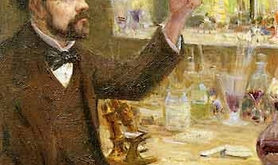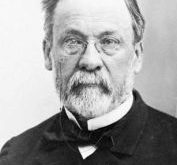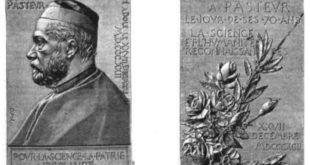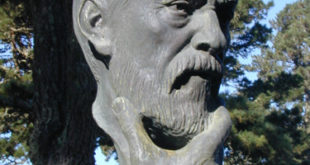Originally published in “The Independent” on December 23, 1922
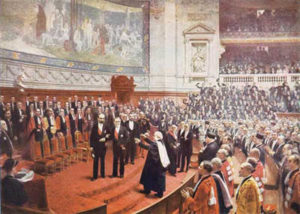
THE French Government has announced the appropriation of 2,000,000 francs with which to celebrate properly the 100th anniversary of the birth of Louis Pasteur. The Government appropriation carries with it the statement that Pasteur stands as “The Symbol of French Science.”
The anniversary date occurs on December 27, and if all who are beholden to Pasteur could be assembled in an evening of celebration, they would probably represent more diversified interests than, perhaps, would assemble to honor any other man of science.
The medical profession, for instance, is beholden to him for the first sterilized bandages, and the first sterilized instruments. Not only did he teach to medical men the theory of Sterilization, but he unfolded to them their first working knowledge of the great world of Microscopia that is invisible to the eye but works a mighty havoc in hospitals and among peoples where contagion may grow into epidemics.
The odd thing about this work for hospital sanitation is that he took the instruments from the hands of a surgeon in a maternity hospital and passed them through a flame to sterilize them, the first time he was ever in a hospital. He was then not a surgeon or physician at all, but an experimenting chemist. The death rate when he entered it was 80 out of every 100 mothers, and the cause of these wholesale deaths was noted down as “childbirth fever.” By the introduction of the flame for instruments between operations, and the bake oven for bandages, Pasteur shifted the death rate from 80 in 100 to 20 in 100.
From the hospital where he first applied surgical instruments to a flame, Pasteur carried his claim, that this should be done, to the Academy of Medicine itself. His biographer, Vallery-Radot, thus describes the reception of his new operative technique:
At the time when Pasteur received the letter (a letter from Sir Joseph Lister, of Edinburgh, crediting Pasteur as the source of the Lister system of antiseptic surgery) people in France were so far from all that concerned antisepsis and asepsis, that, when he advised surgeons at the Academy of Medicine to put their instruments through a flame before using them they did not understand what he meant and he had to explain. . . .
“I mean that surgical instruments merely should be put through a flame, not really heated, and for this reason: if an instrument were examined with a microscope, it would be seen that its surface presents grooves where dusts are harboured, which cannot be completely removed even by the most careful cleansing. Fire entirely destroys these organic dusts; in my laboratory where I am surrounded by dusts of all kinds, I never make use of an instrument without previously putting it through a”flame.”
Pasteur was ever ready to help others, giving them willing advice and information. In November 1874 (subsequent to his election to the Academy of Medicine) he had occasion to notice that a certain cotton-wool dressing had been badly done. … A wound on the dirty hand of a laboring man had been bandaged with cotton wool without having been washed in any way. When the bandage was removed the pus exhaled a repugnant odor, and was found to swarm with vibriones. Pasteur, in a sitting of The Academy of Science, entered into details as to the precautions which are necessary to get rid of germs originally present on the surface of the wound or of the cotton wool; he declared that the layers of cotton wool should be heated to a very high temperature.
The next most interesting thing about this great service to the medical profession is that Pasteur gained his introduction to his task in that direction by exactly the method which makes every chemist who tries to solve practical problems so important to modern industry. Pasteur was at work in his laboratory with problems of fermentation. He had three sets of observed facts to go on. He had noted that dough soured if left too long in fermentation, and that something happened in the baking of bread to kill the action of whatever caused the souring. The French Government had referred to him the problem of the wine that turned sour on voyages of the French fleet so that the sailors would not drink it. And the brewers of France had referred to him the problem of the beer that turned “bitter” in the beer vats.
Starting from the observed fact about bread and soured dough, he wondered if something in the wine could be “killed” by heat that would stop the souring and the conversion into vinegar. So he heated wine samples to various temperatures. It is interesting to note now that a frugal janitor often turned down the gas jet under his samples and so ruined his experiments in these first attempts to find out the death temperature for yeasts in wine and beer, and that the janitor quarreled with Pasteur over wasting “such a lot of flame on such a little sample of wine,” while he was thus at work discovering the real nature of yeast, and the existence in the air of bacteria that affected many human affairs in so many different ways.
He found that heating the wine killed its ferments and left it sweet just as heating the dough did in the making of bread. And so he set the modern wine industry upon its feet.
Beer gave him another remarkable step forward. He found that after he had sweetened bitter beer, it had a tendency to become bitter all over again and did not remain sweet as the wine did—the bread did. He set out “culture mediums” in the breweries—especially on dusty rafters—and obtained from the dust the same germs that he found in the beer. He found that if he kept the beer, after killing its “wild yeasts from the brewery dust” by heat, sealed in tubes with cotton plugs, the beer would remain sweet. Thus he came face to face with the infection theory in all that it means to the medical profession today—and to sanitarians in the control of notifiable, contagious diseases. It was only because Pasteur, looking from his laboratory window, saw ten women carried into a maternity hospital one morning and ten corpses carried out at night, that he stepped over into the medical profession to apply his theories directly to human affairs. The instantaneous response he obtained to his vigorous efforts to reduce the death-rate, opened up to Pasteur the great work of his later life. Chemists must never forget that it was as a chemist that he made these great discoveries. His election to the Academy of Medicine came later in his life, while his fame as a chemist was resounding throughout France.
By the simple “accident” of noting that an epidemic of anthrax swept away horses, cows, pigs, and dogs, and left the chickens, he discovered the importance of temperature in germ growth. He brought to this problem the eternal curiosity that drove him onward through life, and discovered that the hen’s blood was four degrees C. hotter than the blood of mammals. Perhaps he first established himself with the medical profession when he killed hens with anthrax germ inoculation by holding them in water until their temperature was reduced to the normal for mammals and “cured” them when no mammal could be cured by taking them from the cold bath to a warm room. There they took care of the anthrax inoculations for themselves, as the unfavorable temperature for germ growth was created.
Pasteur did not care a cent for “pure science without application.” He called the simple brewers together and taught them night after night in Lille how to prevent bitter beer by washing down the brewery walls and getting rid of all brewery dust. And it was here that modern sanitation really was born.
When he found the germ that was killing the silk worm in France, he proclaimed his discovery far and wide and thus saved the silk industry to France. When he worked out the theory of vaccination, he proclaimed it to all who would hear and he gave the “Pasteur treatment” for rabies even to a boy whom he know would die, he was “so far gone with the disease.” He wanted to yield every ounce of human helpfulness he could.
In America his name is a household word because of the daily delivery to all city homes of “pasteurized milk.” In Algeria a city was named for him, while he still lived, “out of gratitude for his discoveries.” In Canada a district was named for him for a like reason. And we still know nothing better to do with a sufferer from a mad dog’s bite than to rush him to a Pasteur institute. During the siege of Paris, like the great patriot he was, he cried out against surgical practice in the case of gangrene. All around him he saw his companions dying from gangrene following gunshot wounds and declared it was all unnecessary—that the infection must come from air-borne germs which could be killed. The idea was too far ahead of his time. It was not until 1917 that they began to treat gangrene with the Carrel-Dakin solution and thus brought an end to operations for this disease. And at the same time they found that “trench foot,” because of which feet were being cut off by the hundreds in our World War, was only a mold growth and could be handled just as Pasteur had taught bakers and brewers and vineyardists to handle molds. Thus nearly 100 years after his birth the world followed along trails he pointed out. Chemists can never be accused of honoring him too greatly.
 Pasteur Brewing Louis Pasteur – Science, Health, and Brewing
Pasteur Brewing Louis Pasteur – Science, Health, and Brewing 